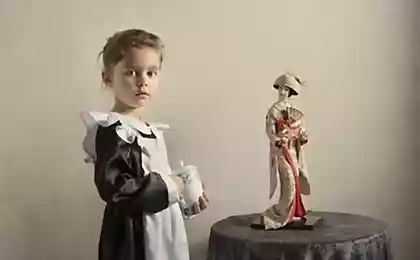350
What to tell a child by ear so that he sleeps peacefully all night
Experienced parents know that a child's sleep at night is so important. However, not everyone manages to immediately accustom the baby to regular sleep, so that he correctly balances with the periods of wakefulness. Fortunately, this topic has been studied far and wide. Therefore, for a long time there have been various techniques and tricks that will help to put the baby in the crib.

© Freepik Today , the Site will try to figure out how to teach your beloved child to fall asleep quickly and sleep without interruption. After all, first of all, it is important for the correct development of the child . And, of course, high-quality children's sleep will save parents' nerves.
Baby's Sleep at Night In this article, we will share several methods that can help young parents get a baby's sleep at night . But there are a number of actual rules, independent of the technique you choose.
First, remember that it is best to start teaching your baby to sleep between 4 and 6 months . The older the children, the more difficult it is to disrupt their sleep patterns. Second, if you leave your baby alone overnight, make sure the baby is warm and comfortable. There should be nothing near him that can interfere with his sleep.

© Freepik Also, be prepared that your child may not like your idea. If he cries, then in this way he simply shows his attitude to what is happening. It will take time to achieve the desired result, and it is individual for each baby.
How to teach a child to sleep The first method is aimed at teaching a child to fall asleep on their own. The so-called "Cry it out" technique is to put the baby in the crib and then leave him alone. Ideally, the child should already be sleepy. To do this, you need to monitor his behavior throughout the day and track signals that indicate that it is time for the baby to sleep. For example, he begins to yawn corny or suck his thumb on his hand.
Further, leaving the child alone, the parent should no longer enter the room. And this is where the most important part of the technique begins. Yes, the baby will surely start crying. But neither dad nor mom can go into the nursery and calm the baby . He must do it himself and get used to falling asleep in the crib without parental guidance.

© Freepik The next method is ferberization. This is the method of Richard Ferber, a renowned physician who has been studying sleep and sleep disorders in children for over 30 years. In essence, this technique is similar to the previous one. However, the doctor allows the parents to enter the room to calm the crying baby. The only difference is in time.
If you hear crying, first wait 3 minutes, and only then calm the baby. Further, the period of time after which parents can enter the nursery should be gradually increased. In addition, it is forbidden to take the child in your arms , feed him and turn on the lights in the room. Also, do not comfort the child for a very long time.
Parenting Techniques The next method is called The Chair Method. If you translate the name literally, you get something like the chair or chair method. What does this mean? Put the child to bed and leave the room immediately. When you hear crying, go back and sit in a chair near the baby's bed. Don't do anything else. Behave as boring as possible so that the kid does not hope for any activity.

Move the chair further away from the bed each time. The child will begin to get used to the fact that your presence does not in any way affect his unwillingness to sleep. Sooner or later, he will reconcile himself to falling asleep under supervision, and will stop crying. And you don't have to go into the room again.
Another method is to put the child to bed and wait for his reaction. If the baby is calm, leave the room.

© Freepik When the child starts crying, you should wait a couple of seconds and see if the child calms down, and then go up to the child and take him to calm him down. Once the baby has calmed down, put him back in the crib (it doesn't matter if he is awake) and let him fall asleep on his own.
The next technique is to lull the child in any way you like. But at the same time, each time you need to reduce the time you spend to put your baby to bed. A matter of habit, nothing more.

The latter technique is based on the needs of the child. In other words, the baby will not fall asleep until he really wants to. Therefore, you need to determine the time at which the child actually falls asleep.
For example, usually you put your baby to bed at 20, but he falls asleep only at 21. For an hour he harasses you crying, although this could have been avoided. Start putting your child to bed at 21, and then gradually change the time to what you need. So the baby will be able to rebuild without realizing it.
What not to do First, the room where the baby sleeps should be dark at night . Only in this way will the baby be able to calm down and begin to produce melatonin, a hormone that regulates sleep. Secondly, always monitor the child's condition. If you see the first signs of sleepiness, it's time to go to bed.

A child's daytime sleep is, of course, good. But you must admit that everything should be in moderation. Make sure that the amount of sleep during the day does not exceed 3 hours . Otherwise, the entire sleep pattern may be disrupted. Also, remember that your child needs a clear daily routine. Knowing what procedures await him before bed, he will be able to relax and prepare for the night.
If you have your own effective methods for teaching your child to sleep regularly, be sure to tell us about them in the comments. Let's share your experiences with each other!

© Freepik Today , the Site will try to figure out how to teach your beloved child to fall asleep quickly and sleep without interruption. After all, first of all, it is important for the correct development of the child . And, of course, high-quality children's sleep will save parents' nerves.
Baby's Sleep at Night In this article, we will share several methods that can help young parents get a baby's sleep at night . But there are a number of actual rules, independent of the technique you choose.
First, remember that it is best to start teaching your baby to sleep between 4 and 6 months . The older the children, the more difficult it is to disrupt their sleep patterns. Second, if you leave your baby alone overnight, make sure the baby is warm and comfortable. There should be nothing near him that can interfere with his sleep.

© Freepik Also, be prepared that your child may not like your idea. If he cries, then in this way he simply shows his attitude to what is happening. It will take time to achieve the desired result, and it is individual for each baby.
How to teach a child to sleep The first method is aimed at teaching a child to fall asleep on their own. The so-called "Cry it out" technique is to put the baby in the crib and then leave him alone. Ideally, the child should already be sleepy. To do this, you need to monitor his behavior throughout the day and track signals that indicate that it is time for the baby to sleep. For example, he begins to yawn corny or suck his thumb on his hand.
Further, leaving the child alone, the parent should no longer enter the room. And this is where the most important part of the technique begins. Yes, the baby will surely start crying. But neither dad nor mom can go into the nursery and calm the baby . He must do it himself and get used to falling asleep in the crib without parental guidance.

© Freepik The next method is ferberization. This is the method of Richard Ferber, a renowned physician who has been studying sleep and sleep disorders in children for over 30 years. In essence, this technique is similar to the previous one. However, the doctor allows the parents to enter the room to calm the crying baby. The only difference is in time.
If you hear crying, first wait 3 minutes, and only then calm the baby. Further, the period of time after which parents can enter the nursery should be gradually increased. In addition, it is forbidden to take the child in your arms , feed him and turn on the lights in the room. Also, do not comfort the child for a very long time.
Parenting Techniques The next method is called The Chair Method. If you translate the name literally, you get something like the chair or chair method. What does this mean? Put the child to bed and leave the room immediately. When you hear crying, go back and sit in a chair near the baby's bed. Don't do anything else. Behave as boring as possible so that the kid does not hope for any activity.

Move the chair further away from the bed each time. The child will begin to get used to the fact that your presence does not in any way affect his unwillingness to sleep. Sooner or later, he will reconcile himself to falling asleep under supervision, and will stop crying. And you don't have to go into the room again.
Another method is to put the child to bed and wait for his reaction. If the baby is calm, leave the room.

© Freepik When the child starts crying, you should wait a couple of seconds and see if the child calms down, and then go up to the child and take him to calm him down. Once the baby has calmed down, put him back in the crib (it doesn't matter if he is awake) and let him fall asleep on his own.
The next technique is to lull the child in any way you like. But at the same time, each time you need to reduce the time you spend to put your baby to bed. A matter of habit, nothing more.

The latter technique is based on the needs of the child. In other words, the baby will not fall asleep until he really wants to. Therefore, you need to determine the time at which the child actually falls asleep.
For example, usually you put your baby to bed at 20, but he falls asleep only at 21. For an hour he harasses you crying, although this could have been avoided. Start putting your child to bed at 21, and then gradually change the time to what you need. So the baby will be able to rebuild without realizing it.
What not to do First, the room where the baby sleeps should be dark at night . Only in this way will the baby be able to calm down and begin to produce melatonin, a hormone that regulates sleep. Secondly, always monitor the child's condition. If you see the first signs of sleepiness, it's time to go to bed.

A child's daytime sleep is, of course, good. But you must admit that everything should be in moderation. Make sure that the amount of sleep during the day does not exceed 3 hours . Otherwise, the entire sleep pattern may be disrupted. Also, remember that your child needs a clear daily routine. Knowing what procedures await him before bed, he will be able to relax and prepare for the night.
If you have your own effective methods for teaching your child to sleep regularly, be sure to tell us about them in the comments. Let's share your experiences with each other!
Quotes that only the most well-read intellectuals can continue
What to do if a pack of barking dogs rushes towards you
























